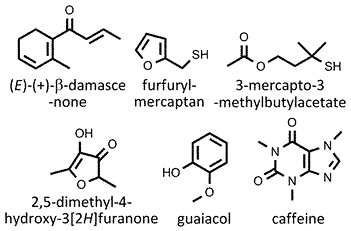 Coffea arabica
Coffea arabica
coffee • Arabian coffee
Back to “Spices: coffee (Coffea arabica)s”
Coffea arabica L. (Rubiaceae); koffie (Afrikaans); ka fei (Chinese); café arabica (French); Kaffee, Arabicakaffee (German); caffè (Italian); arabika koohii (Japanese); café (Portuguese); cafeto (Spanish); kafae (Thai)
DESCRIPTION Washed and dried coffee seeds (“green coffee beans”) are pale yellowish grey but turn dark reddish-brown when roasted. Instant coffee is produced by spray-drying or freeze-drying. Decaffeinated coffee has become available since 1930.1 Coffee is sometimes flavoured with vanilla or cinnamon.
THE PLANT An evergreen shrub or small tree with glossy leaves, fragrant white flowers and two-seeded fleshy fruits (drupes). Coffea canephora (robusta or Congo coffee) is used mainly for instant coffee and C. liberica (Liberian or Abeokuta coffee) is used to add a bitter flavour to blends.1
ORIGIN Highlands of southwestern Ethiopia and the adjacent Boma plateau of Sudan.1 Initially, coffee was a masticatory or infusions of the leaves or fruit pulp were used as beverages. The practice of using the seeds for coffee appears to have started in Ethiopia not long before the 14th century ad. Between ad 1400 and 1700 Arabia (Yemen) maintained a monopoly but Dutch and Portuguese explorers took coffee seeds and seedlings to other tropical regions of the world, where plantations were established.1,2 Brazil and Colombia are today the main producers. At more than $10 billion (in 2000), coffee is second only to petroleum in annual export value.2
CULTIVATION Plants are usually grown from seeds and thrive in tropical or warm temperate climates but can survive subzero temperatures. They do well in containers. Well-drained soil (pH 5 to 7), mulching, regular watering and occasional feeding are recommended.
HARVESTING Fruits are picked by hand when red and fully ripe. They are either directly dried or depulped in order to remove the two seeds.
CULINARY USES Coffee or coffee extract is an important flavouring used in a wide range of desserts, confectionery, ice cream, sweets, candies and liqueurs (e.g. Tia Maria).
FLAVOUR COMPOUNDS More than 800 volatile compounds are formed when coffee is roasted.2,3 The main aroma compounds responsible for the familiar coffee fragrance are (E)-(+)-β-damascenone, furfurylmercaptan, 3-mercapto-3-methylbutylformate (or -acetate), 2,5-dimethyl-4-hydroxy-3[2H]-furanone and guaiacol.2,3 Roasting does not affect the level of caffeine (about 150 mg per cup). During roasting (typically at 185 to 240 ºC for about 12 minutes), residual water in each thick-walled cell in the coffee bean is converted to steam, which results in high pressure and complex chemical reactions (including caramelization), during which sugars combine with amino acids, peptides and proteins to create bittersweet glycosylamines and melanoidins (the dominant taste compounds in coffee).2 The best way to appreciate the complexity of coffee aroma is espresso – strong, black, Italian-style coffee made by passing steam through firmly tamped down, fine to medium-ground coffee. A skilled barista (coffee bar technician) will use 30 seconds percolation time to produce about 30 ml of extract with the all-important crema on top.2

NOTES Another important source of flavour (and caffeine) is the cola nut (Cola acuminata) from West Africa.
1. Wrigley, G. 1995. Coffee. In: Smartt, J., Simmonds, N.W. (Eds), Evolution of crop plants (2nd ed.), pp. 439–442. Longman, London.
2. Illy, E. 2002. The complexity of coffee. Scientific American 286: 86–91.
3. Buffo, R.A., Cardelli-Freire, C. 2004. Coffee flavour: an overview. Flavour and Fragrance Journal 19: 99–104.